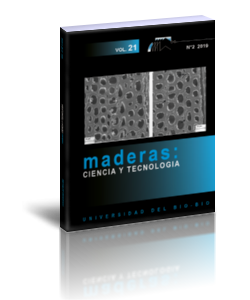Thermal degradation of oriental beech wood impregnated with different inorganic salts
Keywords:
Fagus orientalis, thermal stability, thermogravimetric analysis, wood impregnation, wood protectionAbstract
This study investigated the thermal properties of Oriental beech (Fagus orientalis) treated with (NH4)2HPO4, K2HPO4, NH4Cl and (NH4)2SO4 salts and their mixtures (1:1; w/w) aqueous solutions at 3% concentrations. The effects of different inorganic salts fire retardants on the thermal degradation characteristics of wood samples were evaluated by thermogravimetric analysis (TGA). Based on the TGA curve for untreated beech wood, weight loss takes place at three distinct steps. The impregnation of inorganic salts resulted in higher char yields and additional thermal degradation steps were identified. The highest char yield (80%) was obtained from (NH4)2HPO4-K2HPO4 mixture impregnated sample. Salt mixtures containing phosphates ((NH4)2HPO4 and K2HPO4) have remarkable effects on thermal stability of beech wood, whereas NH4Cl salt lowered the decomposition temperatures and char yield.
Downloads
References
Beall, F.C.; Eickner, H.W. 1970. Thermal degradation of wood components: a review of the literature. U.S. Forest Products Laboratory, 1-26.
Browne, F.L.; Tang, W.K. 1962. Thermogravimetric and differential thermal analysis of wood and wood treated with inorganic salts during pyrolysis. Fire Research Abstracts and Reviews 4(1-2): 76-91.
Browne, F.L.; Tang, W.K. 1963. Effect of Various Chemicals on Thermogravimetric Analysis of Ponderosa Pine. USDA. Forest Products Laboratory. Research Paper FPL-RP-6:1-23.
Collard, F.-X.; Blin, J. 2014. A review on pyrolysis of biomass constituents: Mechanisms and composition of the products obtained from the conversion of cellulose, hemicelluloses and lignin. Renewable and Sustainable Energy Reviews 38:594-608.
Elyounssi, K.; Collard, F.X.; Mateke, J.A.N.; Blin, J. 2012. Improvement of charcoal yield by two-step pyrolysis on eucalyptus wood: A thermogravimetric study. Fuel 96(1):161-167.
Gao, M.; Sun, C.Y.; Wang, C.X. 2006. Thermal Degradation of wood Treated with Flame Retardants. Journal of Thermal Analysis and Calorimetry 85(3): 765-769.
Jeske, H.; Schirp, A.; Cornelius, F. 2012. Development of a thermogravimetric analysis (TGA) method for quantitative analysis of wood flour and polypropylene in wood plastic composites (WPC). Thermochimica Acta 543: 165-171.
Jiang, J.; Li, J.; Hu, J.; Fan, D. 2010. Effect of nitrogen phosphorus flame retardants on thermal degradation of wood. Construction and Building Materials 24(12): 2633-2637.
Kartal, S.N.; Hwang, W.J.; Imamura, Y. 2007. Water absorption of boron-treated and heat-modified wood. Journal of Wood Science 53(5): 454-457.
Keskin, H.; Atar, M.; Izciler, M. 2009. Impacts of impregnation chemicals on combustion properties of the laminated wood materials produced combination of beech and poplar veneers. Construction and Building Materials 23(2): 634-643.
Kurt, R.; Mengeloglu, F. 2011. Utilization of boron compounds as synergists with ammonium polyphosphate for flame retardant wood-polymer composites. Turkish Journal of Agriculture and Forestry 35(2): 155-163.
Kurt, R.; Mengeloglu, F.; Meric, H. 2012. The effects of boron compounds synergists with ammonium polyphosphate on mechanical properties and burning rates of wood-HDPE polymer composites. European Journal of Wood and Wood Products 70(1-3): 177-182.
Liu, X.; Wang, T.; Chow, L.C.; Yang, M.; Mitchell, J.W. 2014. Effects of Inorganic Fillers on the Thermal and Mechanical Properties of Poly(lactic acid). International Journal of Polymer Science 2014(827028): 1-8.
Marney, D.C.O.; Russell, L.J. 2008. Combined Fire Retardant and Wood Preservative Treatments for Outdoor Wood Applications - A Review of the Literature. Fire Technology 44(1): 1-14.
Mohareb, A.; Thevenon, M.F.; Wozniak, E.; Gerardin, P. 2011. Effects of polyvinyl alcohol on leachability and efficacy of boron wood preservatives against fungal decay and termite attack. Wood Science and Technology 45(3): 407-417.
Müller-Hagedorn, M.; Bockhorn, H.; Krebs, L.; Müller, U. 2003. A comparative kinetic study on the pyrolysis of three different wood species. Journal of Analytical and Applied Pyrolysis 68(Special Issue): 231-249.
Obanda, D.N.; Todd F.; Shupe, H.; Barnes, M. 2008. Reducing leaching of boron-based wood preservatives -A review of research. Bioresource Technology 99(15):7312-7322.
Ohashi, H.; Igarashi, S.; Nagaoka, T. 2018. Development of wood structural elements for fire resistant buildings. Journal of Structural Fire Engineering 9(2): 126-137.
Roth, M.; Schwarzinger, C.; Mueller, U.; Schmidt, H. 2007. Determination of reaction mechanisms and evaluation of flame retardants in wood-melamine resin-composites. Journal of Analytical and Applie Pydrolysis 79(1-2): 306-312.
Salman, S.; Petrissans, A.; Thevenon, M.F.; Dumarcay, S.; Perrin, D.; Pollier, B.; Gerardin, P. 2014. Development of new wood treatments combining boron impregnation and thermomodification: effect of additives on boron leachability. European Journal of Wood and Wood Products 72(3): 355-365.
Shafizadeh, F. 1982. Introduction to pyrolysis of Biomass. Journal of Analytical and Applied Pyrolysis 3(4): 283-305.
Slopiecka, K.; Bartocci, P.; Fantozzi, F. 2011. Thermogravimetric analysis and kinetic study of poplar wood pyrolysis. Third International Conference on Applied Energy. 16-18 May Perugia, Italy.
Stimely G.L.; Blankenhorn, P.R. 1985. Effects of Species, Specimen Size and Heating Rate on Char Yield and Fuel Properties. Wood and Fiber Science 17(4): 477-489.
Su, W.Y.S.; Hata, T.; Nishimiya, K.; Imamura, Y.; Ishihara, S. 1998. Improvement of fire retardancy of plywood by incorporating boron or phosphate compounds in the glue. Journal of Wood Science 44(2): 131-136.
Thevenon, M.F.; Tondi, G.; Pizzi, A. 2009. High performance tannin resin-boron wood preservatives for outdoor end-uses. European Journal of Wood and Wood Products 67(1): 89-93.
Tomak, E.D.; Baysal, E.; Peker, H. 2012. The effect of some wood preservatives on the thermal degradation of Scots pine. Thermochimica Acta 547: 76-82.
Yorulmaz, S. Y. 2006. Investigation of Emissions and Combustion Kinetics of Waste Wood Samples with Thermal and Spectral Methods. MSc Thesis: 70-127. Available online Available online https://etd.lib.metu.edu.tr/upload/12607570/index.pdf (access 30/08/2018)
Yunchu, H.; Peijang, Z.; Songsheng, Q. 2000. TG-DTA studies on wood treated with flame retardants. Holz als Roh- und Werkstoff 58(1): 35-38.

































